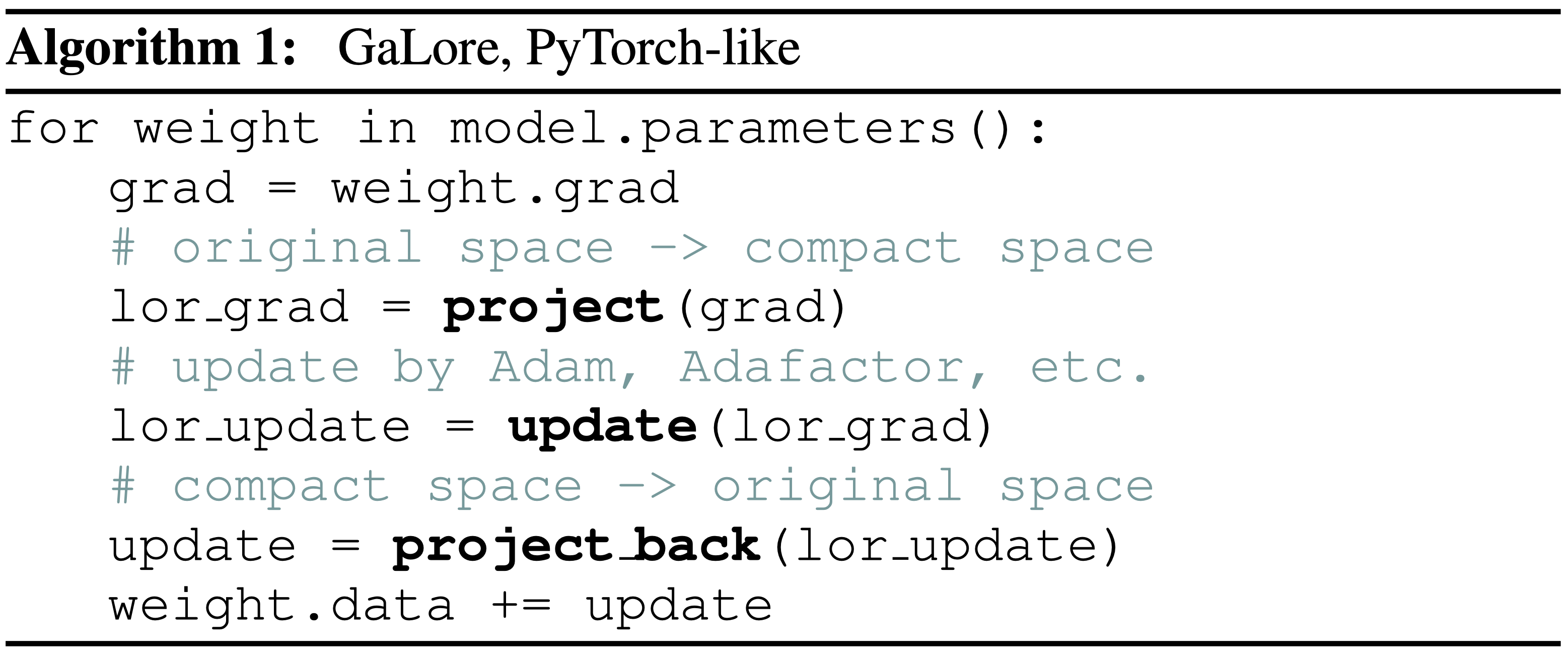This repo contains the pre-release version of GaLore algorithm, proposed by GaLore: Memory-Efficient LLM Training by Gradient Low-Rank Projection.
Gradient Low-Rank Projection (GaLore) is a memory-efficient low-rank training strategy that allows full-parameter learning but is more memory-efficient than common low-rank adaptation methods, such as LoRA. As a gradient projection method, GaLore is independent of the choice of optimizers and can be easily plugged into existing ones with only two lines of code, as shown in Algorithm 1 below.
Thanks everyone for your interest in GaLore!
We are working on the official release of GaLore. In the meantime, please feel free to try the pre-release version and provide feedback to us. Currently, the pre-release version (e.g., GaLore optimizers) should provide a decent memory reduction and accurate simulation of GaLore algorithm.
The official release of GaLore will include:
- Per-layer weight updates for multi-GPU training (DDP and FSDP) (working with PyTorch).
- Memory-efficient low-rank gradient accumulation (working with PyTorch).
- Optimized
GaLoreAdamW8bit(working with bitsandbytes).
We would like to express our gratitude to the community members who have been actively working on integrating GaLore into different platforms, including HuggingFace, LLaMA-Factory, and Axolotl. Join our Slack workspace GaLore-Social to engage in discussions with us.
Discussion (GaLore-Social)
We welcome any discussions, questions, and feedback on GaLore. Please join our Slack workspace GaLore-Social to discuss with us and the community.
Install from pip:
pip install galore-torchor if you want to install from source:
git clone git@github.com:jiaweizzhao/GaLore.git
cd GaLore
pip install -e .pip install -r exp_requirements.txtOur experiment scripts are tested on Python 3.8 with PyTorch 2.1.
from galore_torch import GaLoreAdamW, GaLoreAdamW8bit, GaLoreAdafactor
# define param groups as galore_params and non_galore_params
param_groups = [{'params': non_galore_params},
{'params': galore_params, 'rank': 128, 'update_proj_gap': 200, 'scale': 0.25, 'proj_type': 'std'}]
optimizer = GaLoreAdamW(param_groups, lr=0.01)We use register_post_accumulate_grad_hook provided by PyTorch (torch>=2.1.0) to enable per-layer weight updates. An example is shown below:
# define an optimizer for each parameter p, and store them in optimizer_dict
for p in model.parameters():
if p.requires_grad:
optimizer_dict[p] = GaLoreAdamW([{'params': p, 'rank': 128, 'update_proj_gap': 200, 'scale': 0.25, 'proj_type': 'std'}], lr=0.01)
# define a hook function to update the parameter p during the backward pass
def optimizer_hook(p):
if p.grad is None:
return
optimizer_dict[p].step()
optimizer_dict[p].zero_grad()
# Register the hook onto every parameter
for p in model.parameters():
if p.requires_grad:
p.register_post_accumulate_grad_hook(optimizer_hook)More details can be found in torchrun_main.py.
torchrun_main.py is the main script for training LLaMA models on C4 with GaLore. Our benchmark scripts for various sizes of models are in scripts/benchmark_c4 folder.
For example, to train a 60m model on C4, do the following:
# LLaMA-60M, GaLore-Adam, 1 A100, 1 Node
torchrun --standalone --nproc_per_node 1 torchrun_main.py \
--model_config configs/llama_60m.json \
--lr 0.01 \
--galore_scale 0.25 \
--rank 128 \
--update_proj_gap 200 \
--batch_size 256 \
--total_batch_size 512 \
--num_training_steps 10000 \
--warmup_steps 1000 \
--weight_decay 0 \
--dtype bfloat16 \
--eval_every 1000 \
--optimizer galore_adamw To train a 7B model with a single GPU such as NVIDIA RTX 4090, all you need to do is to specify --optimizer=galore_adamw8bit_per_layer, which enables GaLoreAdamW8bit with per-layer weight updates.
With activation checkpointing, you can maintain a batch size of 16 tested on NVIDIA RTX 4090.
# LLaMA-7B, 8-bit GaLore-Adam, single GPU, activation checkpointing
# bsz=16, 22.8G,
torchrun --standalone --nproc_per_node 1 torchrun_main.py \
--model_config configs/llama_7b.json \
--lr 0.005 \
--galore_scale 0.25 \
--rank 1024 \
--update_proj_gap 500 \
--batch_size 16 \
--total_batch_size 512 \
--activation_checkpointing \
--num_training_steps 150000 \
--warmup_steps 15000 \
--weight_decay 0 \
--grad_clipping 1.0 \
--dtype bfloat16 \
--eval_every 1000 \
--single_gpu \
--optimizer galore_adamw8bit_per_layerCurrently per-layer weight updates technique is only supported for single GPU training (--single_gpu) without using nn.parallel.DistributedDataParallel. We are working on supporting multi-GPU training with per-layer weight updates.
run_glue.py is the main script for fine-tuning RoBERTa models on GLUE tasks with GaLore. An example script is shown below:
python run_glue.py \
--model_name_or_path roberta-base \
--task_name mrpc \
--enable_galore \
--lora_all_modules \
--max_length 512 \
--seed=1234 \
--lora_r 4 \
--galore_scale 4 \
--per_device_train_batch_size 16 \
--update_proj_gap 500 \
--learning_rate 3e-5 \
--num_train_epochs 30 \
--output_dir results/ft/roberta_base/mrpc@misc{zhao2024galore,
title={GaLore: Memory-Efficient LLM Training by Gradient Low-Rank Projection},
author={Jiawei Zhao and Zhenyu Zhang and Beidi Chen and Zhangyang Wang and Anima Anandkumar and Yuandong Tian},
year={2024},
eprint={2403.03507},
archivePrefix={arXiv},
primaryClass={cs.LG}
}